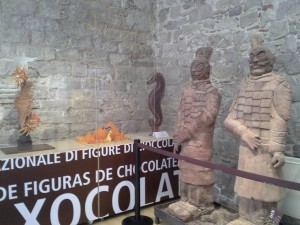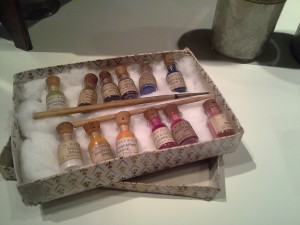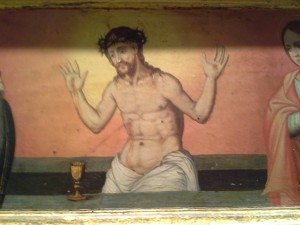Barcelona’s Museums – So Much Culture!
My taller half and I are on a two week trip to Spain and while he is at a Very Important Conference I am getting cultured. Like a yogurt. A yogurt that is visiting many of Barcelona’s Museums.
My first stop was the Museu Maritim de Barcelona, which was a triple dose of history. First, it’s a museum. Second, the building complex in which it is located became a museum in 1941 but had previously been used as a shipyard since the 13th century. Finally, archeology on the site also indicates the presence of a Roman necropolis, because Europe.
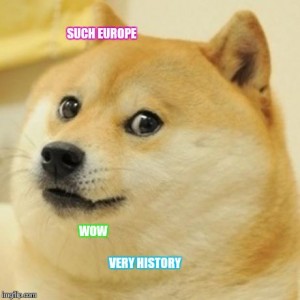 As an American, when faced with this sort of epochal historical context certain parts of my brain overload and I can only burble in internet memespeak.
As an American, when faced with this sort of epochal historical context certain parts of my brain overload and I can only burble in internet memespeak.
But I kept going and looked at the pretty boats and great exhibits which were nicely labeled in Catalan, Castillian Spanish, and English.
I learned that Barcelona’s port contributes 24% of shipping through Spain, including .8 million cars per year. When we passed through here on our 2011 bike tour we arrived on a boat which brought a large number of cars (and two bikes) from Italy and we wondered about it at the time. Now I know that the Barcelonans are aggressively expanding to be the European entry port for Asian goods (via Suez Canal).
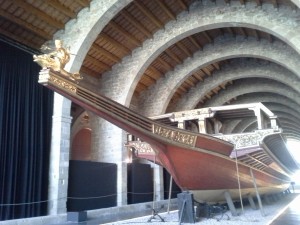
Replica of the flagship in the European fleet that trounced the Turks in 1571 in the Battle of Lepanto. That’s a very important battle in the history of Christianity, so look it up!
In addition to port industry and historical boats, they had exhibits on the history of underwater photography and on travel by boat. The travel section included an ~8 ft long drawing showing the cross section of a late 19th century passenger liner which I seriously coveted and unsuccessfully tried to get a panoramic photo of. Alas! Instead, I give you this Zen koan from MMB: The port is the first and last thing seen by those traveling by sea.
From there I went to the Museu Xocolata, where your ticket is also a chocolate bar with a wrapper appropriate to your country of origin. The museum was notable mostly for the bizarre chocolate sculptures made with varying levels of artistry, presumably by students of the patisserie school in the same building, but I learned a few new facts: Chocolate (as a drink) apparently was acceptable nourishment for monks on fasting days and Catholic nuns in Mexico were the first to think of adding sugar to chocolate.
There was also the local aspect. Barcelona was a pretty big port of entry for goods from the New World, including chocolate, so it ended up with chocolate warehouses and factories, making it the site of the first mechanical production of chocolate in 1777.
I stopped in at the municipal photo archive (upstairs from the chocolate museum) where there was a very small exhibit on early photography techniques which made a good companion to early underwater photo exhibit at MMB. I watched a video showing the whole process of making a daguerrotype and learned that when adding color to photos at the time, “lips” was one of the included hues.
The following day I went to the Monestir de Pedrables, which, like the shipyards of the MMB is so old I can barely fathom it. It was founded in 1326 by/for a Queen Elisenda, the fourth wife of King Jaume II. He died the next year and she, being only in her thirties, lived out the remaining 35 years of her life at the monastery. It continued as an active convent, save for a few brief war-induced interruptions, until the 1970s when the nuns moved to a new facility next door and the place became a public museum. The exhibits include, most impressively, the entire grounds, as well as the expected collection of religious art. Having visited a number of cathedrals on our last European sojourn, the notable thing about the Pedrables religious art is that they mixed and matched to make altar pieces with art by different artists and from different eras, including Catalan paintings next to Flemish visions of the various saints.
Generally, I find that Catholic art leaves me with a lot of questions, like “what is an ostensory?” Or “How come this is the holy family of the fly?” Or “what’s the story behind a painting labeled ‘St. Ursula and the Eleven Thousand Virgins and a Donor’?” Sometimes I feel smart, though, when I see a lady carrying her boobs on a silver platter and I know she’s the patron saint of breast cancer.
Even when you’ve seen all many cathedrals that they all blend together, you still want to check out Gaudi’s Sagrada Familia, which was today’s cultural pilgrimage.
I found it amazing that something made of stone and glass (and light) can seem so soft. In the overhead words of a nearby Canadian tourist, “This is so inspiring, I would come here even if I was an atheist and enjoy it.” The basement has many many iterative models in plaster, both to show the evolution of the cathedral’s design, and to guide them as they work to complete it. Yes, they started in 1883 and, funded by the tickets of several million visitors each year they are hoping to finish in 2026, on the centenary anniversary of Gaudi’s death. Seeing so many plaster casts made me wish that Gaudi were around today so he could have access to CAD & a 3D printer. It would be like Mozart in the mall with Bill & Ted.
